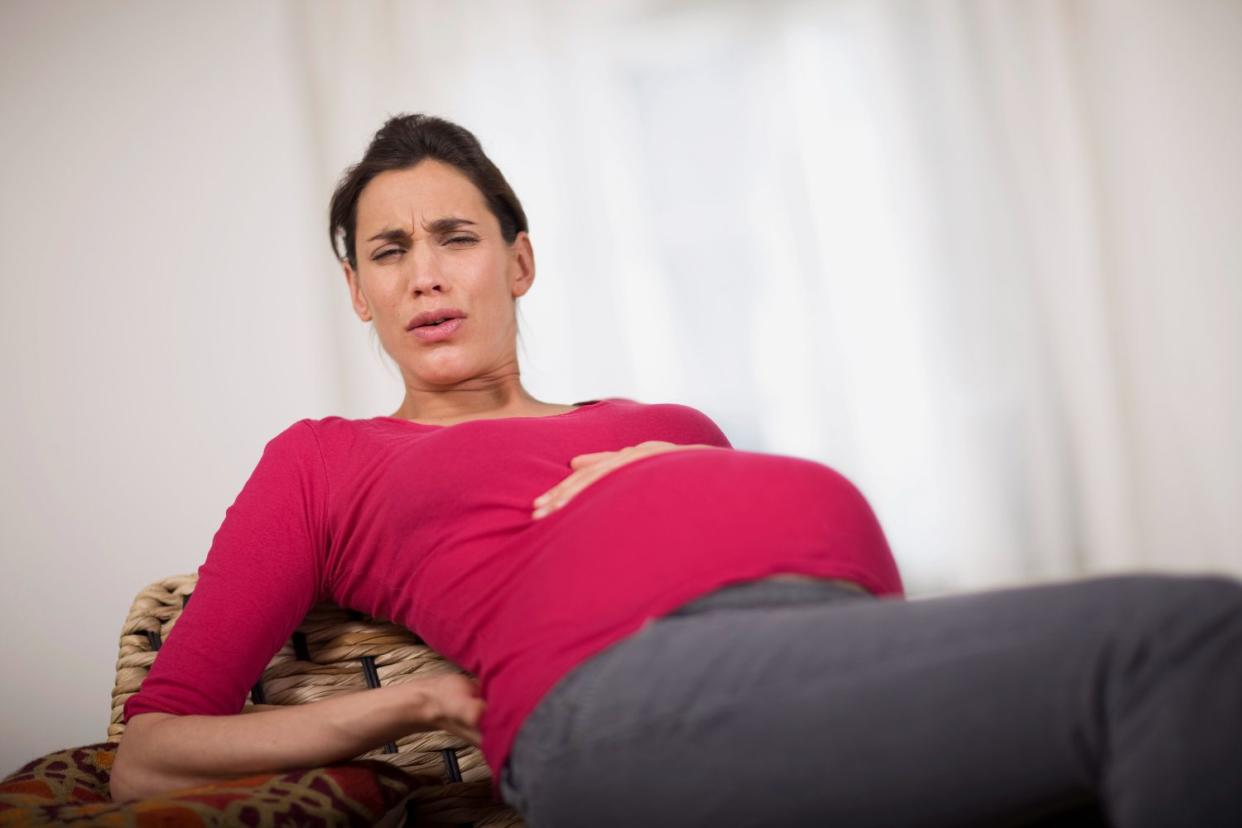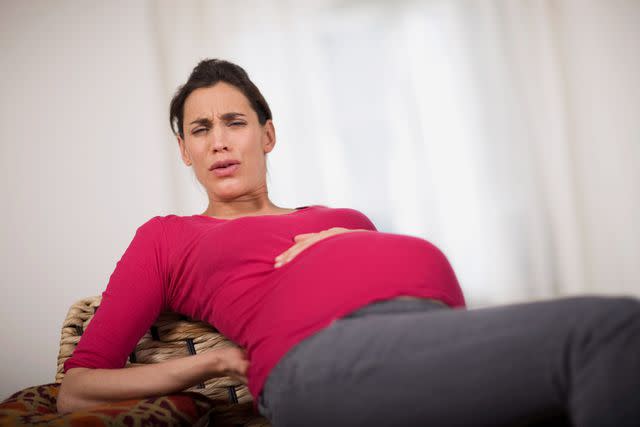What Is Costochondritis?

Zero Creatives / Getty Images
Medically reviewed by Marissa Sansone, MD
Costochondritis is rib pain caused by inflammation of the cartilage (flexible connective tissue) in the rib cage. In this case, it connects the ribs to the sternum (the breastbone between the ribs).
Pregnancy can cause costochondritis as the uterus grows and presses on the rib cage, causing it to expand. You may notice that deep breaths, coughing, or specific movements make it worse.
Though costochondritis is not life-threatening, it can be scary. It often resolves on its own, but it’s best to notify your healthcare provider, especially if the discomfort is severe and does not go away.
This article reviews the signs and symptoms, causes, diagnosis, treatment, and risk factors of costochondritis and how to cope with it.

Zero Creatives / Getty Images
Signs and Symptoms of Costochondritis
The inflammation of the cartilage in the rib cage causes symptoms of costochondritis. These include:
Sharp or aching pain or pressure that may radiate or move to the back or stomach
Pain that can be sudden and spread across the chest (some may think it’s a heart attack)
The sternum (the breastbone in the middle of the ribs) is tender to touch
Multiple ribs are usually affected
Pain that worsens with a deep breath, coughing, or sneezing
Pain that decreases when you stop moving or slow your breathing
Positional pain (gets worse in certain positions, especially when lying in bed)
Costochondritis may be confused with Tietze syndrome, which is less common. Swelling is a symptom unique to Tietze syndrome.
Though costochondritis is not an emergency, the symptoms can mimic those of other serious conditions, like a heart attack. Call 911 if any of these symptoms accompany the chest pain:
Trouble breathing
High fever
Pus, redness, swelling around ribs (possible infection)
Pain gets worse after treatment
Sharp pain with every breath
Nausea (queasy, uneasy, or upset stomach)
Unusually sweaty
Heart palpitations (heart flutters, feels too strong, skips a beat, or is irregular)
Severe headache
Causes
Pregnancy can cause costochondritis, especially in the third trimester (weeks 28–40), if the uterus presses against the bottom of the ribs. The cartilage also loosens, allowing the rib cage to expand. These pregnancy changes can cause inflammation and pain.
Chest discomfort during pregnancy can also result from indigestion (heartburn) and growing breasts. Though some mild rib or chest pain is expected during pregnancy, call your healthcare provider if you are experiencing severe pain.
Other non-pregnancy-related causes of costochondritis include:
Severe coughing
Chest injury
Strenuous exercise or exertion
Heavy lifting
Infections such as pneumonia
Related:Chest Tightness: Causes and Finding Relief
Diagnosis
Costochondritis is often diagnosed by exclusion or differential diagnosis, meaning your healthcare team rules out other, more severe conditions before diagnosing you with costochondritis. Other issues or conditions that could cause chest pain include:
Rib fractures
Lung or heart problems
Pneumothorax (collapsed lung)
Tumors
Pulmonary embolism (a blood clot that travels to the main blood vessel leading to the lungs)
Your healthcare provider will ask you questions about your activity level or if you’ve moved or lifted something heavy and will ask questions about the type, location, and timing of the pain. They will also physically examine or palpate your chest to check for tenderness, swelling, and discoloration.
If your history and physical indicate severe pain or possible underlying conditions, they may want to order further tests. This is also true if your pain does not improve with time or treatment. These diagnostic tests may include the following:
Radiography (X-ray or chest X-ray)
Treatment
Treatment for costochondritis generally focuses on treating underlying conditions and providing pain relief while the injury heals.
Sometimes costochondritis resolves on its own with rest, avoiding strenuous activity, and breathing exercises. It may also help to use a cushion, wedge, or body pillow when trying to find a comfortable position when lying down.
Suggested or prescribed treatments may also include:
Warm showers
Avoiding movement that makes it worse
Over-the-counter (OTC) pain medications such as Tylenol (acetaminophen)
Topical (on the skin) medications
Topical medications are becoming more popular because they don’t absorb into the system. They come in patches, creams, or gels that can be placed or rubbed over sore areas. Some decrease swelling, while others help numb the area with lidocaine. Common topical medications include:
BENGAY (menthol, camphor, or methyl salicylate)
Icy Hot (methyl salicylate-menthol)
Oruvail, Orudis, Nexcede, Actron (ketoprofen)
Biofreeze (menthol)
Salonpas (methyl salicylate, menthol and tocopheryl acetate (vitamin E), and camphor)
Tiger balm (camphor, menthol, capsicum, and methyl salicylate)
Blue-Emu (glucosamine and methylsulfonylmethane (MSM))
Related:Is Ice or Heat Better for Treating an Injury?
Risk Factors
Some research suggests that you may be more prone to costochondritis if you are a Hispanic person or were assigned female at birth. Other risk factors include:
Pregnancy
Physical strain or recent strenuous exercises or activities
Unusual upper body twisting or movement
Moving or lifting heavy items
Recent lung infection or illness
Severe or chronic coughing
Coping
Normal pregnancy conditions or anything that causes strain on your chest can trigger costochondritis. This could be an activity as simple as reaching for a spice in a cabinet or tying your shoe. If you notice a movement that increases discomfort, ask for help completing that task until you heal.
Resting in a comfortable position will often relieve the pain. It may help to use a pregnancy or body pillow to help you find a comfortable position while lying down.
Talk with your healthcare provider before taking any medications, including prescription and over-the-counter (OTC) medications. They can help you determine if a medication is safe during pregnancy.
If you are pregnant, you may be concerned that getting an X-ray is not safe for the developing fetus. Any adverse effects from radiation exposure are minimal but it’s best to let your healthcare provider know if you are or may be pregnant. Your radiology provider may choose another diagnostic tool or provide a lead apron or shield that covers your abdomen (belly) to protect against radiation.
Summary
Costochondritis is rib pain caused by inflammation of the cartilage in the rib cage. Anything that puts a strain on your chest area can cause it. During pregnancy, the rib cage expands and may cause costochondritis.
The inflammation causes pain that can mimic a heart attack. You may notice that some activities or even deep breaths make it worse. Though costochondritis is not life-threatening, seeing a healthcare provider so they can rule out severe conditions is best.
Treatment focuses on underlying conditions or providing pain relief. Sometimes costochondritis resolves on its own, but healing could also require rest, avoiding specific movements, warm showers, or medications.
A Word From Verywell
Pregnancy alone can be stressful, but chest pain during pregnancy can be scary. Rest assured that it is common. Most chest discomfort during pregnancy is not serious but is worth mentioning to your healthcare provider. They can rule out a more serious condition, give you peace of mind, and help you decrease discomfort.

